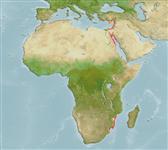Common names from other countries
Environment: milieu / climate zone / depth range / distribution range
Sinh thái học
; Mức độ sâu 1 - 100 m (Ref. 83938). Tropical; 46°N - 30°S, 32°E - 37°E (Ref. 275)
Circumglobal in warm to temperate waters.
Length at first maturity / Bộ gần gũi / Khối lượng (Trọng lượng) / Age
Maturity: Lm ? range ? - ? cm Max length : 18.0 cm ML con đực/không giới tính; (Ref. 105659); common length : 80.0 cm TL con đực/không giới tính; (Ref. 417); Khối lượng cực đại được công bố: 2.0 kg (Ref. 275)
Minimum depth from Ref. 104052. Also caught by artisanal fishing gears (spears, hooks, lures, and traps; Ref. 417). Maximum total length ranges from 120 to 150 cm (Ref. 3722). Found in coralline bottoms (Ref. 417), coral reefs, sandy and rubble bottoms, particularly in subtidal areas (Ref. 83938).
Life cycle and mating behavior
Chín muồi sinh dục | Sự tái sinh sản | Đẻ trứng | Các trứng | Sự sinh sản | Ấu trùng
Members of the class Cephalopoda are gonochoric. Male and female adults usually die shortly after spawning and brooding, respectively. Mating behavior: Males perform various displays to attract potential females for copulation. During copulation, male grasp the female and inserts the hectocotylus into the female's mantle cavity where fertilization usually occurs. Life cycle: Embryos hatch into planktonic stage and live for some time before they grow larger and take up a benthic existence as adults.
Schneider, W. 1990. (Ref. 417)
IUCN Red List Status (Ref. 130435)
CITES status (Ref. 108899)
Not Evaluated
Not Evaluated
Human uses
Các nghề cá: Tính thương mại
| FishSource | Biển chung quanh ta
Các công cụ
Thêm thông tin
Age/SizeSự sinh trưởngLength-weightLength-lengthHình thái họcẤu trùngSự phong phú
Các nguồn internet
Estimates based on models
Preferred temperature
(Ref.
115969): 20.3 - 26.4, mean 24.5 (based on 60 cells).
Vulnerability
Low vulnerability (10 of 100).
